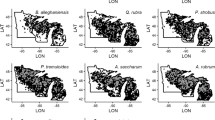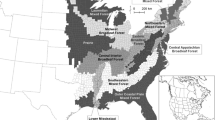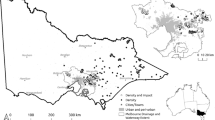Abstract
Red deer (Cervus elaphus) are mixed feeders that consume both herbaceous and woody plants. As a consequence, intensive browsing on trees where red deer populations are particularly dense often leads to serious conflicts between the interests of forestry and hunting stakeholders. Therefore, understanding the density of deer that forest system can bear requires the ability to measure amount of potential forage provided by non-commercial tree species within a stand that serve as forage. Our objective was to build models that estimate forage potential (i.e., maximum biomass edible and accessible for consumption by red deer per tree) based on tree size [i.e., stem base diameter (d0)]. We developed models for three tree species commonly consumed by red deer in Central Europe, aspen (Populus tremula), goat willow (Salix caprea) and rowan (Sorbus aucuparia). To construct models of forage potential, we harvested 380 young (age of 2–15 years) trees on 14 sites in the Western Carpathians of Slovakia. Tree biomass was first divided into three components (stem bark, branches and foliage), each of which was subdivided into edible and non-edible portions based on branch diameter and height from the ground and then dried and weighed. We then quantified edible biomass by tree species, tree component and season (growing vs. dormant). The total amount of tree mass (forage potential) that could be consumed by red deer generally increased with tree size, but the relative contributions of different tree components varied by tree size, tree species and season. Our models predicted that the maximum forage potential per tree was ~ 500 g in aspen, 350 g in goat willow and 300 g in rowan in summer, and nearly 500 g in aspen, 300 g in goat willow and 250 g in rowan in winter. Together with theoretical knowledge and practical experience, our forage potential models can be used to help forest and wildlife managers both to better measure edible tree biomass for red deer populations and how edible tree biomass might be used to minimize the risk of deer damaging commercially valuable trees.




Similar content being viewed by others
References
Akaike H (1974) A new look at the statistical model identification. T Automat Contr 19:716–723
Barančeková M, Krojerová-Prokešová J, Homolka M (2007) Impact of deer browsing on natural and artificial regeneration in foodplain forest. Fol Zool 56:354–364
Basey JM, Jenkins SH, Busher PE (1988) Optimal central-place foraging by beavers: tree-size selection in relation to defensive chemicals of quaking aspen. Oecologica 76:278–282
Bernard M, Boulanger V, Dupouey JL, Laurent L, Montpied P, Morin X, Picard JF, Said S (2017) Deer browsing promotes Norway spruce at the expense of sliver fir in the forest regeneration phase. For Ecol Manag 400:269–277
Blujdea VNB, Pilli R, Dutca I, Ciuvat L, Abrudan IV (2012) Allometric biomass equations for young broadleaved trees in plantations in Romania. For Ecol Manag 264:172–184
Bošeľa M, Konôpka B, Šebeň V, Vladovič J, Tobin B (2014) Modelling height to diameter ratio—an opportunity to increase Norway spruce stand stability in the Western Carpathians. Lesn Cas For J 60:71–80
Boulanger V, Dupouey JL, Archaux F, Badeau V, Baltzinger Ch, Chevalier R, Corcket E, Dumas Y, Forgerad F, Marell A, Montpied P, Paillet Y, Picard J-F, Said S, Ulrich E (2017) Ungulates increase forest plant species richness to the benefit of non-forest specialist. Glob Chang Biol 24:e485–e495
Bucyanayandi J-D, Bergeron J-M, Soucie J, Thomas DW, Jean Y (1992) Differences in nutritional quality between herbaceous plants and bark of conifers as winter food for the vole Microtus pennsylvanicus. J Appl Ecol 29:371–377
Burneviča N, Jansons A, Zaluma A, Klavina D, Jansons J, Gaitnieks T (2016) Fungi inhabiting bark stripping wounds made by large game on stems of Picea abies (L.) Karst. in Latvia. Balt For 22:2–7
Čermák P, Horsák P, Spiřík M, Mrkva V (2009) Relationship between browsing damage and woody species dominance. J For Sci 55:23–31
Červený J, Hell P, Slamečka J (2013) Otto’s Encyclopeda Game Management. Otto’s Publisher, Praha, p 591
Chevallier-Redor N, Verheyden-Tixier H, Verdier M, Dumont B (2001) Foraging behaviour of red deer Cervus elaphus as a function of the relative availability of two tree species. Anim Res 50:57–65
Côté SD, Rooney TP, Tremblay J-P, Dussault Ch, Waller DM (2004) Ecological impacts of deer overabundance. Annu Rev Ecol Evol Syst 35:113–147
Dearing MD, Mangione AM, Karasov WH (2000) Diet breadth of mammalian herbivores: nutrient versus detoxification constraints. Oecologia 123:397–405
Diáz-Yánez O, Mola-Yudego B, González-Olabarria JR (2017) What variables make a forest stand vulnerable to browsing damage occurrence? Silva Fenn 51:1693
Duffy JE, Cardinale BJ, France KE, McIntyre PB, Thébault E, Loreau M (2007) The functional role of biodiversity in ecosystems: incorporating trophic complexity. Ecol Lett 10:522–538
Edenius L, Ericsson G (2015) Effects of ungulate browsing on recruitment of aspen and rowan: a demographic approach. Scand J Forest Res 30:1–6
Ferrari SLP, Cribari-Neto F (2004) Beta regression for modelling rates and proportions. J Appl Stat 31:799–815
Finďo S, Petráš R (2007) Ecological Principals of Forest Protection to Game Damage. National Forest Centre, Zvolen, p 186 (in Slovak)
Gebert C, Verheyden-Tixier H (2001) Variations of diet composition of red deer (Cervus elaphus L.) in Europe. Mammal Rev 31:189–201
Gill RMA (1992) A review of damage by mammals in north temperate forests. 1. Deer. For 65:145–169
Gill RMA, Morgan G (2010) The effects of varying deer density on natural regeneration in woodlands in lowland Britain. Forestry 83:53–63
Hanzal V, Košinová K, Pokorný R, Janiszewski P, Hart V (2018) Weight parameters of body parts in sika deer (Cervus nippon nippon) from the Konstantinolázeňsko microregion, the Czech Republic. Cent Eur For J 64:6–23
Hell P, Gašparík J, Kartusek V, Paule L, Slamečka J (2000) Special Animal Husbandry. Technical University, Zvolen, p 228 (in Slovak)
Heroldová ME, Jánová J, Suchomel L, Purchart M, Homolka M (2009) Bark chemical analysis explains selective bark damage by rodents. Beskydy 2:137–140
Hjältén J, Palo T (1992) Selection of deciduous trees by free ranging voles and hares in relation to plant chemistry. Oikos 63:477–484
Holá M, Ježek M, Kušta T, Červený J (2016) Evaluation of winter food quality and its variability for red deer in forest environment overwintering enclosures vs. free-ranging areas. Lesn Cas For J 62:139–145
Homolka M (1990) Food of Cervus elaphus in the course of the year in the mixed forest habitat of the Drahanská vrchovina highlands. Folia Zool 39:1–13
Hull IT (2018) Influences of fuel reduction treatments on the nutritional ecology of deer in northeastern Washington. MS. Thesis, School of the Environment, Washington State University, Pullman, WA
Jamrozy G (1980) Winter food resources and food preferences of red deer in Carpathian forests. Acta Theriol 24:221–238
Jayakody S, Sibbald AM, Mayes RW, Hopper RJ, Gordon IJ, Lambin X (2011) Effects of human disturbance on the diet composition of wild red deer (Cervus elaphus). Eur J Wildl Res 57:939–948
Kaštier P, Bučko J (2011) Influence of ungulate game to the Tatry forest ecosystems damaged by the windstorm. In: Kunca A. (ed): Current issues in forest protection. proceedings of international conference held on April 28th and 29th in Nový Smokovec. National Forest Centre, Zvolen, pp. 114–118 (in Slovak)
Kiffner C, Rössiger E, Trisl O, Schulz R, Rühe F (2008) Probability of recent bark stripping damage by red deer (Cervus elaphus) on Norway spruce (Picea abies) in low mountain range in Germany—a preliminary analysis. Silva Fenn 42:125–134
Kint V, Hein S, Campioli M, Muys B (2010) Modelling self-pruning and branch attributes for young Quercus robur L. and Fagus sylvatica L. trees. For Ecol Manag 260:2023–2034
Konôpka B, Pajtík J, Šebeň V, Bošeľa M (2012) Estimates of young ash tree dendromass eaten by red deer using allometric models. Rep For Res 57:283–294
Konôpka J, Kaštier P, Slamečka J (2014) Conception for Development of Game Management in the Slovak Republic Hunting Studies 12. National Forest Centre, Zvolen, p 86
Konôpka J, Kaštier P, Konôpka B (2015) Theoretical bases and practical measures to harmonise the interests of forestry and game management in Slovakia. Lesn Cas For J 61:114–123
Konôpka B, Pajtík J, Konôpka J, Kaštier P (2017) Forage potential for red deer on rowan—laying (felled) versus standing (live) trees. In: Kunca A. (ed): Current Issues in Forest Protection. Proceeding of International Conference Held on January 26th and 27th, 2017 in Nový Smokovec. National Forest Centre, Zvolen, p.110–118 (in Slovak)
Konôpka B, Pajtík J, Shipley LA (2018) Intensity of red deer browsing on young rowans differs between freshly-felled and standing individuals. For Ecol Manag 429:511–519
Kupferschmid AD, Wasem U, Bugmann H (2015) Ungulate browsing leads to height and diameter growth reduction on Abies alba saplings planted along light gradients. Eur J For Res 134:75–87
Ligot G, Gheysen T, Lehaire F, H ́ebert J J, Licoppe A, Lejeune P, Brostaux Y (2013) Modeling recent bark stripping by red deer (Cervus elaphus) in South Belgium coniferous stands. Ann For Sci 70:309–318
Manson J, Roberge J-M, Edenius L, Bergström R, Nilsson L, Lidberg M, Komstedt K, Ericsson G (2015) Food plot as a habitat management tool: forage production and ungulate browsing in adjacent forest. Wildl Biol 21:246–253
Moore NP, Hart JD, Kelly PF, Langton SD (2000) Browsing by fallow deer (Dama dama) in young broadleaved plantations: seasonality, and the effects of previous browsing and bud eruption. Forestry 73:437–445
Motta R (2003) Ungulate impact on rowan (Sorbus aucuparia L.) and Norway spruce (Picea abies (L) Karst.) height structure in mountain forests in the eastern Italian Alps. For Ecol Manag 181:139–150
Myking T, Solberg EJ, Austrheim G, Speed JDM, Bohler F, Astrup R, Eriksen R (2013) Browsing of sallow (Salix caprea L.) in the context of life history strategies: a literature review. Eur J For Res 132:399–409
Pajtík J, Konôpka B, Bošeľa M, Šebeň V, Kaštier P (2015) Modelling forage potential for red deer: a case study in post-disturbance young stands of rowan. Ann For Res 58:91–107
Pajtík J, Konôpka B, Šebeň V (2018) Mathematical biomass models for young individuals of forest tree species in the region of the Western Carpathians. National Forest Centre, Zvolen, p 89
Popp JN, McGeachy DNC, Hamr J (2013) Elk (Cervus elaphus) seasonal habitat selection in a heterogeneous forest structure. IJFR, ID, p 415913
R Development Core Team (2012). R: A language and environment for statistical computing. Vienna: R foundation for statistical computing. webpage: http://www.R-project.org/
Rajský M, Vodňanský M, Slamečka J, Kropil R, Rajský D (2008) Influence supplementary feeding on bark browsing by red deer (Cervus elaphus) under experimental conditions. Eur J Wildl Res 54:701–708
Ramirez JI, Jansen PA, den Ouden J, Goudzwaard L, Poorter L (2019) Long-term effects of wild ungulates on the structure, composition and succession of temperate forests. For Ecol Manag 432:478–488
Raspé O, Findlay C, Jacquemart A-L (2000) Sorbus aucparia L. J Ecol 88:910–930
Reimoser F, Gossow H (1996) Impact of ungulates on forest vegetation and its dependence on the on the silvicultural system. For Ecol Manag 88:243–252
Renaud PC, Verheyden-Tixier H, Dumont B (2003) Damage to saplings by red deer (Cervus elaphus): effect of foliage height and structure. For Ecol Manag 181:31–37
San-Miguel-Ayanz J, De Rigo D, Caudullo G, Houston Durrant TH, Mauri A (eds) (2016) European Atlas of Forest Tree Species. Publication Office of European Union, Luxembourg, p 200
Schulze ED, Bouriad O, Wäldchen J, Eisenhauer N, Walentowski H, Seele C, Heinze E, Pruschitzki G, Danila G, Marin D, Hessenmöller L, Bouriaud L, Teodosiu M (2014) Ungulate browsing causes species loss in deciduous forests in-dependent of community dynamics and silviculture management in Central and Southern Europe. Ann For Res 57:267–288
Šebeň V (2017) The National Forest Inventory in the Slovak Republic 2015–2016 Forestry Studies 63. Zvolen, National Forest Centre, p 255 (in Slovak with English Summary)
Shipley LA, Blomquist S, Danell K (1998) Diet choices by free-ranging moose in relation to plant distribution, chemistry, and morphology in northern Sweden. Can J Zool 76:1722–1733
Shipley LA, Illius AW, Danell K, Hobbs NT, Spalinger DE (1999) Redicting bite size selection of mammalian herbivores: a test of a general model of diet optimization. Oikos 84:55–68
Speed JD, Meisingset EL, Austrheim G, Hester AJ, Mysterud A, Tremblay J-P, Solberg EJ (2013) Low intensities of red deer browsing constrain rowan growth in mature boreal forests of western Norway. Ecoscience 20:311–318
Szukiel E (1981) Food preferences of deer in relation to winter fodder including woody plants. Acta Theriol 26:319–330
Trdan S, Vidrih M (2008) Quantifying the damage of red deer (Cervus elaphus) grazing on grassland production in southeastern Slovenia. Eur J Wild Res 54:138–141
Vacek Z (2017) Structure and dynamics of spruce-beech-fir forests in Nature Reserves of the Orlické hory Mts. in relation to ungulate game. Cent Eur For J 63:1–9
Verheyden H, Ballon P, Bernard V, Saint-Andrieux C (2006) Variations in bark-stripping by red deer Cervus elaphus across Europe. Mammal Rev 36:217–234
Wang Y, Titus SJ, LeMay VM (1998) Relationships between tree slenderness coefficient and tree or stand characteristics for major species in boreal mixedwood forests. Can J For Res 28:1171–1183
Westoby M (1978) What are the biological basis of varied diets? Am Nat 112:627–631
Acknowledgements
The research was supported by the project APVV-18-0086 from the Slovak Research and Development Agency, also by grant “EVA4.0,” No. CZ.02.1.01/0.0/0.0/16_019/0000803 financed by OP RDE as well as by the project “Research and innovation for supporting competitiveness of the Slovak forestry sector” (SLOV-LES) financed by the Ministry of Land Management and Rural Development of the Slovak Republic.
Author information
Authors and Affiliations
Corresponding author
Additional information
Communicated by Christian Ammer.
Publisher's Note
Springer Nature remains neutral with regard to jurisdictional claims in published maps and institutional affiliations.
Rights and permissions
About this article
Cite this article
Konôpka, B., Pajtík, J., Bošeľa, M. et al. Modeling forage potential for red deer (Cervus elaphus): a tree-level approach. Eur J Forest Res 139, 419–430 (2020). https://doi.org/10.1007/s10342-019-01250-x
Received:
Revised:
Accepted:
Published:
Issue Date:
DOI: https://doi.org/10.1007/s10342-019-01250-x




